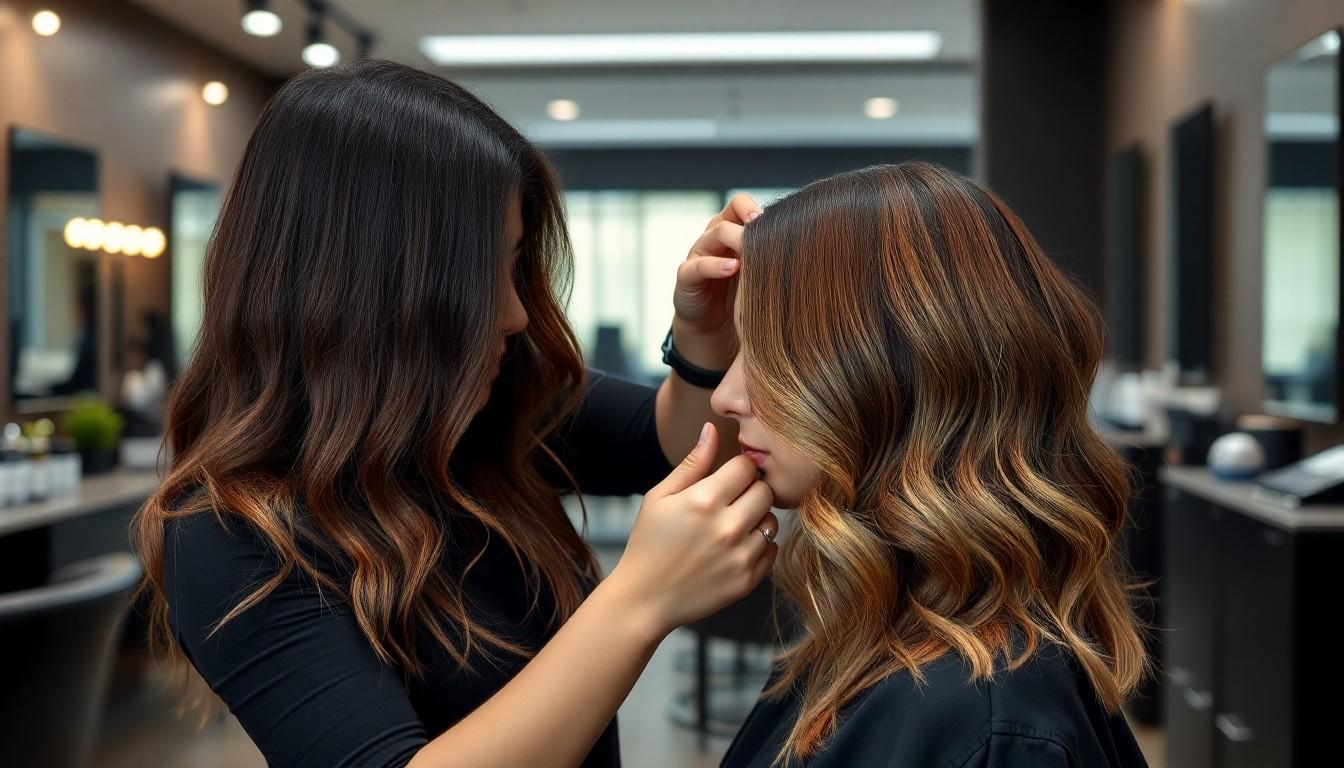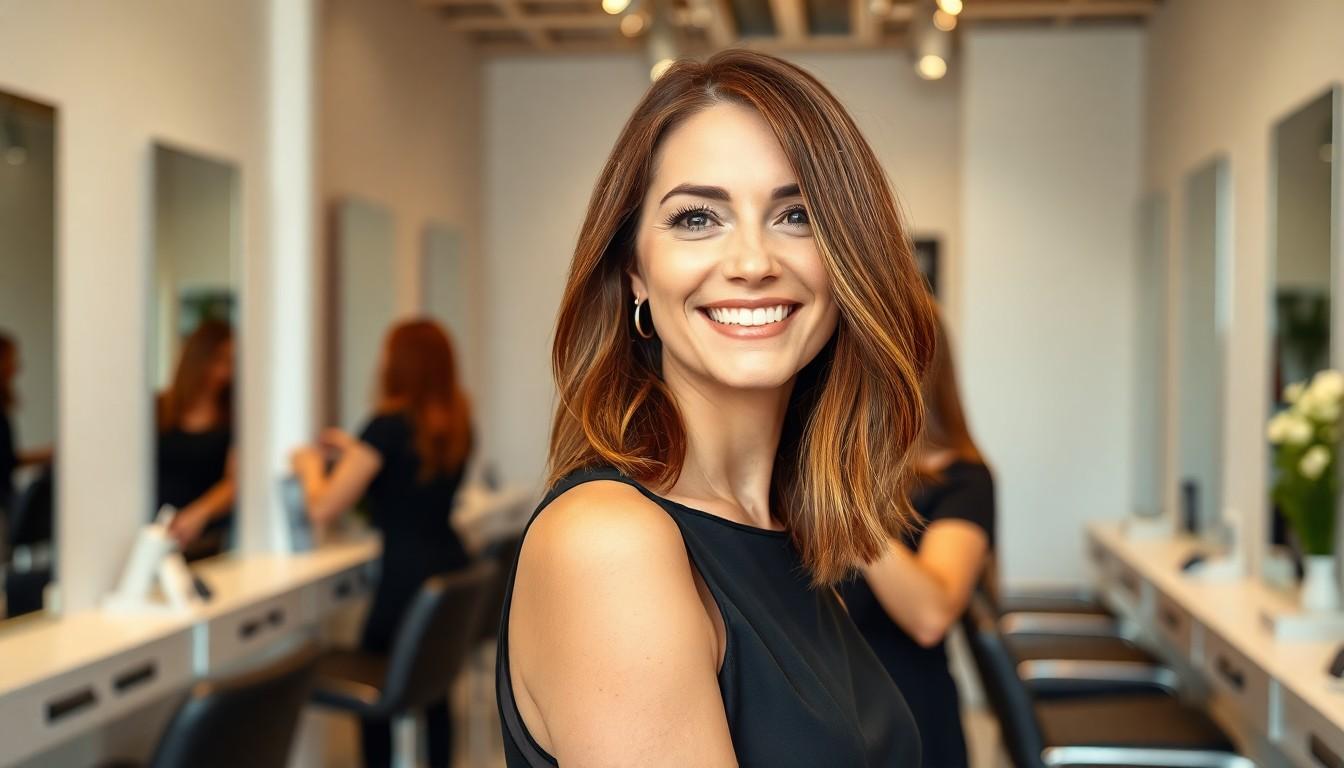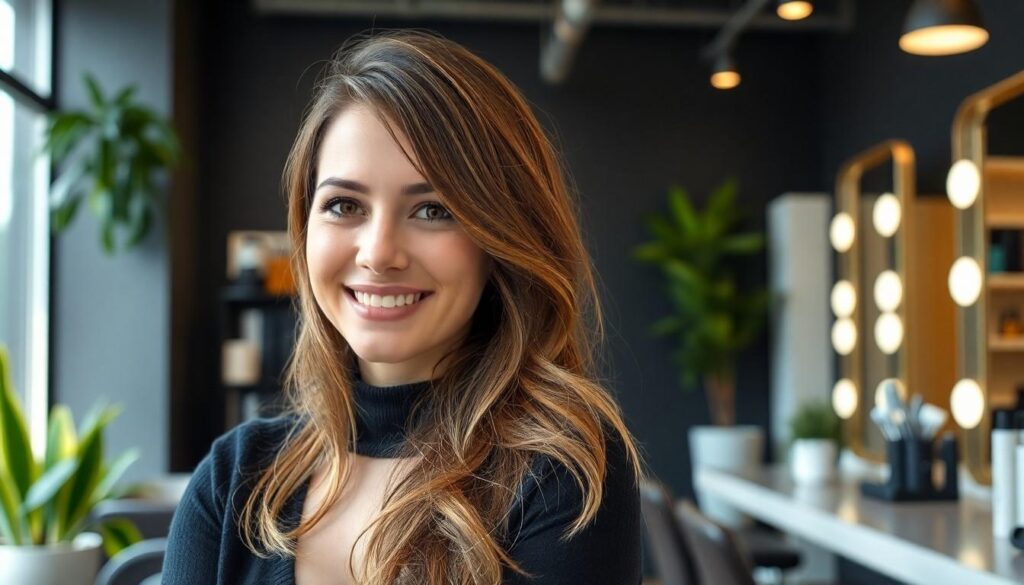The infamous “Karen cut” has become a style to avoid at all costs in today’s beauty industry. This notorious haircut—characterized by its short, angled bob with heavily stacked layers—has unfortunately become associated with entitled behavior and demanding attitudes. We’ve all seen the memes and viral videos that have cemented this hairstyle’s reputation.
We understand you want to look stylish without unwittingly adopting a haircut that sends the wrong message. That’s why we’ve put together this essential guide to help you navigate your next salon visit with confidence. With a few simple tweaks and alternatives, you can enjoy a modern, flattering short hairstyle without venturing into “Karen” territory.
Understanding What Defines a “Karen Cut” Hairstyle
The infamous “Karen cut” has become a recognizable symbol in popular culture, representing more than just a hairstyle but an entire stereotype of behavior. Before deciding on your next haircut, it’s important to understand what exactly constitutes this polarizing style.
Origins of the Karen Haircut Stereotype
The Karen haircut stereotype emerged in the late 2010s alongside internet memes depicting entitled, middle-aged white women demanding to “speak to the manager.” Social media platforms like Twitter and Reddit accelerated this phenomenon, with the name “Karen” becoming shorthand for someone exhibiting privileged, demanding behavior in public spaces. Fashion analysts note that the haircut became associated with this character type around 2018, when viral videos of public confrontations began featuring women with similar hair styles. The meme quickly evolved from representing exact behavioral incidents to encompassing both attitude and appearance, with the distinctive haircut becoming the visual shorthand for the personality type.
Common Characteristics to Avoid
The classic Karen cut features several distinctive elements that have become red flags in modern hairstyling. An asymmetrical bob with a dramatically longer front and shorter back (often called an “inverted bob”) serves as the foundation. Chunky highlights with stark contrast between blonde and darker undertones create a dated, striped appearance. Heavily stacked layers at the back produce a distinctive wedge shape when viewed from behind. Side-swept bangs that swoop across the forehead complete the look, often accompanied by excessive volume at the crown achieved through aggressive teasing. Many stylists point out that excessive hair spray creating a stiff, immovable finish further defines this style. The cut typically includes sharp angles rather than soft transitions between lengths, resulting in a geometric rather than natural-looking silhouette.
Communicating Effectively With Your Stylist

Being direct about your concerns is crucial when trying to avoid the “Karen cut.” We recommend explicitly telling your stylist that you want to steer clear of characteristics associated with this stereotype, such as inverted bobs or excessive layering.
Bringing Clear Reference Photos
Visual aids significantly improve communication with your stylist about the look you’re trying to achieve. Always bring multiple reference photos showing hairstyles you like and dislike to your appointment. Stylists rely heavily on visual examples to understand your vision, especially when avoiding exact styles like the “Karen cut.” For instance, if you want a classic bob without the distinctive Karen features, having photos will guide your stylist in creating a look that aligns perfectly with your preferences. These references eliminate confusion and ensure both you and your stylist are working toward the same end result.
Using Precise Terminology for What You Want
Mastering the right vocabulary helps ensure you get exactly the haircut you desire. Describe your preferred style using exact terminology that leaves no room for misinterpretation. Several key phrases can help you avoid the “Karen cut” characteristics:
- Request a bob without the bell-shaped silhouette that’s commonly associated with the Karen style
- Ask for a soft nape to prevent your hair from appearing too blunt or boxy at the back
- Discuss proper management of any cowlicks by suggesting texturizing shears to soften them rather than fighting against them
- Specify your preferences for layering, mentioning that you want subtle layers instead of the heavily stacked ones typical of Karen cuts
- Clearly describe your desired bangs style, perhaps requesting side-swept bangs that aren’t overly long or straight
Communicating these details precisely leaves little chance for misunderstanding and helps ensure you walk out with a contemporary, flattering style that avoids any negative stereotypes.
Top Flattering Alternatives to the Karen Haircut

Looking for a stylish haircut that won’t give off “Karen” vibes? We’ve compiled some modern, flattering alternatives that will keep you looking fresh and contemporary.
Modern Bob Variations
Softer, blended bobs offer an elegant alternative to the harsh Karen cut. These styles feature gentle angles from front to back, avoiding the dramatic stacked layers that define the stereotypical Karen haircut. Many stylists recommend this variation for a friendlier, more modern appearance that flatters a variety of face shapes.
Asymmetrical bobs with natural color tones create an edgy effect without negative connotations. The key difference lies in the color treatment—instead of chunky highlights with stark contrasts, these bobs incorporate blended, natural-looking color transitions that complement your skin tone. This subtle approach maintains the interesting silhouette while eliminating the dated look associated with the Karen style.
Stylish Mid-Length Options
Layered mid-length cuts provide movement and texture without harsh angles. These versatile styles fall between the chin and shoulders, offering the perfect balance of sophistication and manageability. Soft layers throughout create natural movement without the choppy, spiky look that characterizes the Karen haircut.
Side-swept bangs paired with subtler cuts create elegance without dramatic contrasts. Unlike the Karen cut’s severe side-swept fringe, these bangs integrate more naturally into the overall hairstyle. Stylists often recommend this option for those who want face-framing elements without committing to the stereotypical Karen silhouette. The bangs blend seamlessly with longer layers, creating a cohesive look that feels current and stylish.
Key Elements That Make a Haircut Look Contemporary

Texture and Layering Techniques
Incorporating strategic layers is essential for achieving a modern, non-Karen look. For women, softly layered bobs create movement and depth without the harsh stacking associated with dated styles. Men can benefit from styles like the Modern Pompadour or Textured Haircut that use layers to add volume while maintaining a contemporary edge. Strategic layering helps hair appear more ever-changing and less rigid, instantly updating your appearance.
Adding texture to your hair transforms it from flat and one-dimensional to vibrant and modern. Women can enhance natural texture using sea salt sprays or texturizing products that create effortless movement. Men should consider texturizing paste or lightweight styling cream to achieve that desirable tousled finish. Texture breaks up the severe lines common in the Karen cut, resulting in a more youthful and on-trend appearance.
The Importance of a Natural-Looking Silhouette
Avoiding overly structured or boxy cuts prevents the dreaded Karen silhouette from forming. We recommend opting for haircuts with softer edges and more relaxed lines that frame your face naturally. The Revitalized Pixie Cut features soft layers and longer bangs that create a flowing silhouette rather than a harsh geometric shape. Natural silhouettes move with you and appear less contrived than their overly structured counterparts.
Tailoring your haircut to complement your face shape ensures a contemporary look that works specifically for you. A softly layered bob can be customized to flatter various face shapes, making it versatile and modern. Face-framing techniques that consider your unique features create a personalized silhouette that avoids the one-size-fits-all approach of the Karen cut. This customized approach results in a haircut that appears thoughtfully designed rather than copied from an outdated trend.
Contemporary Styling Tips
Embrace a less polished finish by avoiding over-styling your hair. Using light-hold hairspray or flexible styling products allows for natural movement that looks current and effortless. Rigid, helmet-like styles scream dated, while touchable hair with some natural movement signals modern sophistication. Let your hair have some personality rather than forcing it into submission.
Incorporate casual elements like relaxed side parts or purposefully undone textures to achieve a contemporary vibe. The Messy Crop and Beachy Highlights trend exemplify styles that embrace a more natural aesthetic over perfect precision. These relaxed approaches to styling communicate a confident, current attitude that stands in direct opposition to the uptight Karen stereotype. Casual doesn’t mean sloppy—it means approachable and current.
How to Update Your Current Style Without a Dramatic Change

Updating your style doesn’t require dramatic transformations. Small, strategic changes can help you avoid outdated looks like the “Karen cut” while maintaining your personal comfort zone.
Small Modifications That Make a Big Difference
Mixing classic and modern elements creates an instantly refreshed look without a complete style overhaul. Try pairing your favorite classic blouse with trendy pants or a contemporary skirt to achieve this balance. Accessories offer another effortless way to elevate your existing wardrobe—modern statement jewelry, stylish belts, and leather handbags can transform simple outfits into fashion-forward ensembles.
Updating silhouettes represents another subtle yet effective modification. Blend traditional patterns with contemporary cuts to maintain your personal style while incorporating fresh elements. For example, traditional embroidery or motifs on modern-shaped garments creates a fusion that feels both familiar and new.
Modern fabrics and textures instantly refresh your look without changing your overall aesthetic. Consider adding pieces made from sustainable materials or incorporating unique textures like velvet and faux leather into your wardrobe rotation. These small fabric changes signal style awareness without requiring a dramatic departure from your comfort zone.
Incorporating Modern Details
Bold prints and asymmetrical patterns offer easy ways to incorporate contemporary details into your existing style. These modern elements can transform traditional garments—even something as simple as an asymmetrical hemline can update a classic silhouette. Unique embellishments also provide opportunities to refresh your look without committing to major changes.
Versatility remains key when modernizing your style. Invest in adaptable pieces like stylish dresses, coordinated separates, statement tops, and trendy jumpsuits that complement your existing wardrobe. These versatile items create many outfit combinations while maintaining your personal style essence.
Focus on small details rather than complete transformations when updating your look. A modern neckline, updated sleeve style, or contemporary color palette can refresh your appearance without venturing into “Karen” territory. These subtle modifications help you maintain your authentic style while ensuring you present a current, sophisticated image.
Finding the Right Cut for Your Face Shape

Face shape plays a crucial role in determining which hairstyle will flatter your features and help you avoid the dreaded Karen cut. Understanding your unique facial structure allows you to select a style that enhances your natural beauty rather than working against it.
Round Faces
Round faces benefit from styles that create the illusion of length and angles. Avoid hairstyles with excessive volume on top, as they can make your face appear even rounder. Instead, opt for cuts with longer layers that frame the face and create vertical lines. Side-swept bangs can help slim a round face, while an asymmetrical style that’s longer than the typical Karen cut can add definition without the harsh look.
Square Faces
Square faces need softening elements to balance strong jawlines. Softer layers and more blended looks work wonders to complement angular features rather than emphasizing them. Skip the harsh-angled bob characteristic of the Karen cut, which can accentuate squareness. Curved bangs and face-framing pieces create a softening effect, while medium-length cuts with subtle waves add femininity and movement to counterbalance angular features.
Oval Faces
Oval face shapes can support various styles, but that doesn’t mean the Karen cut is your best option. Maintain balance by avoiding overly short backs with dramatically longer fronts. Choose styles that maintain the natural harmony of your face shape rather than disrupting it with stark contrasts. Soft layers that flow naturally work particularly well for oval faces, creating movement without the signature Karen stiffness.
Heart-Shaped Faces
Heart-shaped faces, characterized by wider foreheads and narrower chins, need cuts that balance these proportions. Avoid the Karen cut’s tendency to create volume at the crown, which can emphasize a wider forehead. Styles that add width at the jawline help create balance, while side-swept bangs soften the forehead without the harsh diagonal lines typical of Karen cuts.
Customizing Length and Layers
Balanced proportions serve as the foundation for avoiding the Karen cut aesthetic. The stark contrast between the length in front and back creates that distinctive Karen silhouette, so consider styles with more harmonious transitions from shorter to longer sections. Gradual layering creates a more contemporary look than the abrupt stacking commonly associated with the Karen cut.
Layers should enhance your natural hair texture rather than fighting against it. Excessive layering and stacking contribute heavily to the stereotypical Karen appearance, especially when paired with artificial volume. Opt for softer, more blended layering techniques that add movement and dimension without creating that telltale structured helmet appearance.
Custom-customized layers should follow the natural fall of your hair. Discuss your daily styling routine with your stylist to ensure your layers work with your lifestyle and maintenance preferences. Even short haircuts can avoid the Karen look by incorporating softer edges and more natural movement through thoughtful layering techniques.
Framing Features Appropriately
Bangs require particular attention when avoiding the Karen cut. Lengthy side bangs that create a diagonal line across the face often contribute to the entitled Karen appearance. Instead, choose side-swept bangs that integrate more naturally with the rest of your hairstyle, creating a softer frame for your face. Off-center straightened side bangs particularly evoke the Karen stereotype and should be avoided.
Facial feature enhancement should guide your styling choices. The typical Karen cut often draws attention to facial features in unflattering ways, particularly with its deep side parts and crisp, blended layers. Soften these elements for a more modern, approachable look that frames your features without overwhelming them.
Color plays a important role in avoiding the Karen appearance. Abrupt color contrasts and chunky highlights create a confrontational, intense look commonly associated with the stereotype. Subtle, natural tones and blended highlights achieve an edgy yet friendly appearance that avoids the harsh, dated Karen aesthetic. Dimensional color that moves naturally with your layers creates depth without falling into the Karen territory.
Working With Your Natural Hair Texture

Working with your natural hair texture rather than fighting against it is fundamental to avoiding the dreaded “Karen cut.” Let’s explore how to embrace your hair’s natural properties for a more flattering, modern look.
Cuts That Enhance Rather Than Fight Your Texture
Choosing a haircut that complements your natural texture creates harmony and reduces daily styling struggles. For those with curly or wavy hair, we recommend avoiding excessive layering and sharp angles that can create frizz and unmanageable volume. Straight-haired individuals should opt for softer layers with blended transitions that enhance natural flow rather than creating harsh lines. The notorious “Karen cut” typically features an aggressive inverted bob with a stark contrast between the longer front and shorter back—instead, select a smoother, more balanced bob that transitions gracefully throughout. Balance is crucial when considering inverted bobs; ensure the length differential isn’t extreme to avoid that telltale “Karen” silhouette. Subtle layering techniques can add movement without creating the chunky, stacked effect that dates your look immediately. A classic bob with gentle, strategic layers offers sophistication while maintaining a contemporary edge that works with your natural texture.
Styling Products That Support Your Look
The right styling products can make all the difference in maintaining a modern, non-Karen aesthetic. Color choices significantly impact the overall impression of your cut—avoid the harsh, chunky highlights often associated with the “Karen look” and instead embrace more natural, blended color transitions like subtle highlights or balayage. Texture-exact products should be selected based on your hair’s natural tendencies; light hold styling creams work wonderfully for wavy textures, while volumizing mousses can add body to finer hair without creating artificial stiffness. Creating a smooth, polished finish helps counter the over-styled appearance typical of dated cuts—we suggest incorporating a quality hair serum or light-hold hairspray to achieve this refined look. Products that enhance rather than mask your natural texture result in hair that moves naturally and appears healthy. Styling tools should be used judiciously, focusing on accentuating your hair’s inherent qualities rather than forcing it into an unnatural shape that fights against its texture.
Color Considerations That Complement Modern Cuts

Moving Away From Harsh Highlights
Harsh highlights have become a telltale sign of the outdated “Karen cut” style that many are trying to avoid. Traditional foiled highlights often create stark, unnatural contrasts that can age your look significantly. Instead, opt for natural blending techniques that integrate color seamlessly throughout your hair. Multi-dimensional approaches combine various shades to replicate the natural variation found in hair color, adding visual interest without the jarring effect of single-tone highlights. Customized color applications customized to your exact hair type and desired outcome ensure a modern finish that enhances rather than detracts from your cut.
Dimensional Color Techniques
Dimensional hair color adds depth, contrast, and richness by incorporating multiple complementary shades. Highlights and lowlights work together to create balance—lighter shades brighten while darker tones add depth, resulting in a multi-faceted appearance that looks natural and sophisticated. Balayage offers a freehand highlighting technique that delivers a sun-kissed effect without foils, blending highlights seamlessly for a subtle dimensional result. Ombre creates a gorgeous gradient from roots to ends, typically transitioning from darker to lighter shades for a smooth, natural-looking dimension. Color melting blends multiple hues together for a seamless transition between shades, eliminating harsh lines and creating a unified, multi-dimensional appearance that perfectly complements modern haircuts.
Maintenance Tips for Keeping Your Style Current

Maintaining a stylish, contemporary haircut requires consistent attention and proper care. Here’s how to ensure your style stays fresh and avoids drifting into outdated territory.
Regular Trims
Regular trims are essential for maintaining the shape and health of your haircut, especially when avoiding the Karen cut. These maintenance appointments help reshape your haircut as it grows out, ensuring it maintains a balanced and even appearance rather than developing into an unflattering silhouette. Scheduling trims every 6-8 weeks prevents uneven growth and maintains the integrity of your layers, particularly at the back where volume can become problematic. Without consistent maintenance, even the most stylish cut can gradually transform into an outdated style as it grows out improperly.
Communication with your stylist during these regular appointments creates opportunities to make minor adjustments before small issues become major style problems. We recommend bringing reference photos to your maintenance appointments, not just your initial styling session, to help visualize any evolving preferences. Using hair accessories like headbands, scarves, or stylish clips between appointments can temporarily refresh your look while waiting for your next trim.
Regular Trim Schedules
Establishing a consistent trim schedule allows for gradual adjustments to your haircut, which is particularly important if you’re growing out an unwanted style. Your appointment frequency might vary based on your hair type and growth rate, but maintaining a regular 6-8 week schedule works well for most shorter, layered cuts that risk developing Karen-like characteristics. Mark these appointments on your calendar in advance to avoid waiting until your style has already lost its shape.
Seasonal adjustments to your trim schedule might be necessary, as humidity and temperature changes can affect how your hair behaves and grows. Shorter styles typically require more frequent maintenance to preserve their intended shape and prevent them from evolving into something unintended. Following a regular trim schedule provides opportunities for minor course corrections rather than major overhauls, keeping your style consistently current.
When to Consider a Style Refresh
Identifying exact issues with your current cut helps determine when it’s time for more than just a trim. Pay attention to warning signs like difficulty styling, excessive volume at the crown, or a growing bell shape that might indicate your cut is evolving toward unwanted territory. Your stylist can provide targeted answers when you clearly communicate which aspects of your haircut need addressing, whether that’s length, layers, asymmetry, or color.
Restyling becomes necessary when regular trims no longer correct the fundamental issues with your cut. Consider a complete restyle if your current cut consistently requires excessive styling to look good or if you find yourself hiding it under hats and accessories. Temporary answers like hair extensions can add length and volume while you’re growing out an unflattering cut, bridging the awkward phase between styles.
Hair color adjustments offer another way to refresh your style without dramatically changing the cut. A skilled colorist can help find complementary shades that update your look and avoid the chunky highlights often associated with dated styles. Seasonal style assessments provide natural opportunities to evaluate whether your current cut still serves you well or if it’s time for a more important change.
Conclusion: Embracing Timeless Style Over Trendy Stereotypes
Avoiding the “Karen cut” isn’t just about steering clear of a stereotype—it’s about choosing a hairstyle that truly enhances your features and reflects your personality. With the right communication techniques and understanding of what makes a modern cut we’ve shared throughout this guide you’ll be well-equipped for your next salon visit.
Remember that contemporary style balances personal expression with current trends. By considering your face shape natural texture and maintenance preferences you can find a flattering alternative that keeps you looking fresh and vibrant.
The perfect haircut is one that makes you feel confident and beautiful while remaining timeless. Trust your instincts work with your stylist and embrace a style that’s authentically you—never defined by internet memes or outdated stereotypes.
Frequently Asked Questions
What exactly is a “Karen cut” hairstyle?
A “Karen cut” is a short, angled bob hairstyle that became associated with entitled behavior through internet memes in the late 2010s. It typically features an asymmetrical shape with a longer front and shorter back, chunky highlights, heavily stacked layers, and excessive volume. The style gained negative connotations around 2018 when viral videos showed women with similar haircuts displaying demanding behavior.
How can I avoid getting a Karen haircut at the salon?
Be direct with your stylist about what you don’t want, specifically mentioning you prefer to avoid severely inverted bobs or excessive layering. Bring clear reference photos of styles you like and dislike. Use precise terminology when describing your preferred hairstyle, such as requesting a bob without a bell-shaped silhouette. Discuss how to manage any cowlicks or hair growth patterns.
What are some modern alternatives to the Karen haircut?
Consider softer, blended bobs with gentle angles for a friendlier appearance. Asymmetrical bobs with natural color tones offer edginess without negative associations. Layered mid-length cuts provide movement without harsh angles. For something completely different, explore textured pixie cuts or longer bobs with subtle layers that maintain a contemporary feel while avoiding dated characteristics.
How does face shape affect choosing a non-Karen hairstyle?
Different face shapes require tailored approaches. Round faces benefit from lengthening styles with subtle layers. Square faces look best with softening elements like side-swept bangs. Oval faces can wear most styles but should avoid excessive volume at the crown. Heart-shaped faces balance well with chin-length cuts that aren’t severely angled. Choose a style that complements your unique features rather than following outdated trends.
How important is hair color in avoiding the Karen stereotype?
Very important. The Karen cut is often associated with chunky, contrasting highlights. Opt instead for natural-looking color with subtle dimension like balayage, babylights, or soft ombré effects. Multi-dimensional color creates depth without harsh lines. Even if your cut has some structural similarities to the Karen style, modern color techniques can significantly update your look.
What maintenance is required to keep my hairstyle from evolving into a Karen cut?
Schedule regular trims every 6-8 weeks to maintain your haircut’s intended shape and prevent it from growing into an unflattering silhouette. Be vigilant about your style developing telltale Karen characteristics like the bell shape or harsh angles. Consider seasonal style assessments and minor adjustments to keep your look contemporary. Work with your natural texture rather than fighting it with excessive styling.
Can I update my style without drastically changing my haircut?
Absolutely. Make small, strategic modifications like softening harsh angles or updating your color technique. Incorporate modern styling products that enhance texture without stiffness. Add contemporary accessories to elevate your overall look. Sometimes subtle changes in how you style your existing cut can make a significant difference in avoiding dated appearances while maintaining your personal comfort level.
How should I communicate with my stylist about avoiding a Karen cut?
Use visual references rather than just verbal descriptions. Bring photos of both what you like and dislike. Use specific terminology about shape, volume, and texture rather than just saying “not a Karen cut.” Discuss your lifestyle, styling abilities, and maintenance preferences. Establishing clear communication ensures your stylist understands exactly what you want to avoid and what contemporary elements you prefer.














